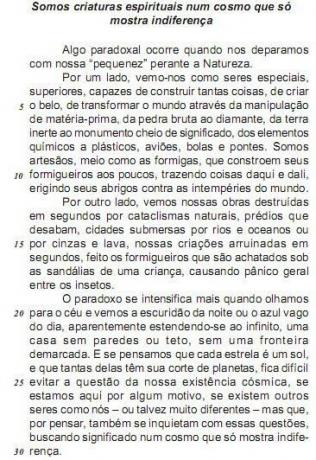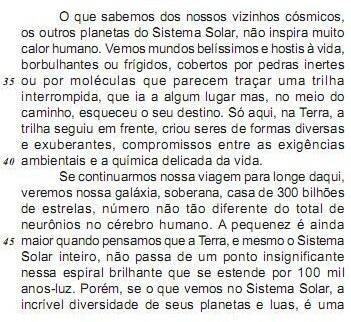Antithesis is a stylistic resource that contrasts terms with opposite meanings to highlight an idea in the speech. Not to be confused with paradox, another resource that uses opposing ideas in discourse.
Read too: Irony – figure of speech that consists in suggesting the opposite of what is stated
What is antithesis?
The antithesis is a figure of speech used to enhance and intensify the meaning of what is said through the use of terms withopposite senses in speech. It is, therefore, a thought figure, that is, the one whose effect is given by the meaning of the words.
THE opposition of meanings can be between words, between expressions or even between sentences. When the terms used appear close together in the utterance, a relationship is created that intensifies the meaning of the discourse. The antithesis also occurs in nonverbal language.
examples of antithesis
"Soft water in rock hard hits until it pierces."
(Popular saying)
"What the cradle gives, only the grave takes away."
(Esau and Jacob, by Machado de Assis)
"His soul of him ascended to heaven
His body went down to the sea”
(Ismalia, by Alphonsus de Guimaraens)
The antithesis is also common in non-verbal language: by bringing contrasting elements together, it generates a highlighting effect.
Do not stop now... There's more after the advertising ;)
antithesis and paradox
O paradox, or oxymoron, is also a figure that uses opposite senses to convey a message more intensely. However, while the antithesis consists in the mere use of opposite terms in the utterance, the paradox builds a relationship between these terms in order to create a message apparently contradictory.
"He knew how to be innocent or malicious when necessary."
In the previous statement there is a antithesis, since there is opposition between innocence and malice, but the person is sometimes innocent, sometimes malicious. So, despite the opposition, it doesn't send a contradictory message.
"There was a mischievous innocence in his gaze."
In this statement there is a paradox, since, in addition to the opposition between innocence and malice, an apparently meaningless relationship is established: malicious innocence.
See too: Hyperbole - figure of speech that expresses purposeful exaggeration
speech figures
Speech figures are style resources used to create effects in speech. They are important to more efficiently convey ideas, concepts and sensations that would not be possible due to the restricted use and literal of language.

solved exercises
Question 1 - (Cesgranrio)


Antithesis is a figure of speech with which an opposition of ideas is highlighted through sentences or words. The fragment that contains an antithesis is:
A) “We are artisans, kind of like ants,” (L. 8-9)
B) “we see our works destroyed in seconds by natural cataclysms,” (L. 12-13)
C) “if we think that each star is a sun, and that so many of them have their court of planets, it is difficult to avoid the question of our cosmic existence,” (L. 23-25)
D) “When looking at the Universe, man is nothing. When looking at the Universe, man is everything.” (L. 53-54)
E) "we are how the Universe thinks about itself." (L. 69-70)
Resolution
Alternative D. There is an antithesis between the terms “nothing” and “everything”.
Question 2 - (FGV) An antithesis is a type of figurative language in which there is the presence of two words of opposite meaning; the sentence below in which the presence of an antithesis does NOT occur is:
A) "A good businessman hires optimists as salespeople and pessimists for the credit department."
B) "I will never apply for or refuse a job, nor will I ever resign."
C) “Luck is the calculation well done. Bad luck is the miscalculation.”
D) "Every exit is an entrance to something else."
E) "Better to deal with the problems of success than with the stagnation of failure."
Resolution
Alternative B. There are no terms with an opposite meaning in the statement, unlike what occurs in alternatives A (optimistic vs. pessimistic), C (lucky vs. bad luck), D (output vs. input) and E (success vs. failure).
Would you like to reference this text in a school or academic work? Look:
VIANA, William. "Antithesis"; Brazil School. Available in: https://brasilescola.uol.com.br/gramatica/antitese.htm. Accessed on June 27, 2021.


